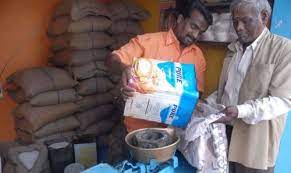Ram Rattan Sharma
State resources are continuously utilized in the name of poverty alleviation and disparity reduction. Even after 75 years of independence, the country is still suffering from poverty and disparities. A series of welfare schemes over the last 70 years have failed to end the miseries of the bottom segments of population in the economic ladder. In the past few years, technology has played a key role in food distribution. Most states have now digitized their PDS to pass on subsidy benefits to targeted group of beneficiaries. The objective is that the cash transfers can directly improve the economic lives of poor, and raise economic efficiency by reducing leakages and market distortions.
It is widely accepted that India’s welfare system is suffering with leakages. Rampant corruption diverted the benefits intended for the poor to the pockets of middlemen and corrupt officials. Neither the system covers the genuine beneficiaries nor does it support the recipients with total number of benefits. Consequently, near 22 percent of the population is still living below poverty line. Aadhar based cash transfer, cash less environment, efficiency in communication and administration are different initiatives of govt to pass on direct benefits to the poor.
Public distribution system was introduced after 2nd world war due to severe food shortages in the country. Initially, the subsidy was common to all in 1990’s. Public distribution system was restructured to include hilly and inaccessible areas. Finally the scheme was moved with a targeted approach and is known as targeted PDS under Essential Commodities Act 2001, and in this context Public distribution system order was passed. It governs rules regarding identification of beneficiaries and commodities to be included for PDS. Department of rural development through BPL survey decides criteria for inclusion or exclusion of beneficiaries. Central Govt allocates food grains as per list prepared by NITIAayog based on families of BPL category to each state. Enactment of Food Security Act,2013 has done away with the need for BPL based identification.
Major challenges in the PDS system emanates from bogus ration cards, belonging to ficticious families and shadow ration cards, that is genuine ration cards are being used by someone else. Global positioning system of truck movement and electronic weigh bridge are inadequate and easily by passable. Leakages of various forms cannot be avoided through this way. Transparency in beneficiary database followed by tracking of individual beneficiary off take, coupled with a computerized MIS system can effectively improve the PDS system. By leveraging e-governance, initiatives can minimize leakage and pilferage.
The govt should create a quality beneficiary database by conducting house to house survey and by enrolling each family member in to unique ID programme. Information of each family member must be digitised. The digitized database will contain ten finger biometrics and photographic information of all family members. This enrolled data would be sent to unique identity authority of India for printing on the ration card for each member to avoid card duplication. The inclusion of all families in the beneficiary database is important for an effective elimination of shadow and bogus cards. Eligible beneficiaries sometimes do not avail of their entire allotment due to immediate unavailability of funds, usage of own farm grains and temporary absence in the locality. But fair price shop owners report a complete off take of allotments. The most ideal option is the deployment of point of sale system, equipped with a fingerprint reader to identify a beneficiary. This data can be updated each month in the database server. As the server data are available and accessible everywhere. It also creates considerable flexibility in the choice of FPS for the consumer and introduces competitiveness between different FPS.
Information communication technology infrastructure needs to be deployed to connect all the key offices, block offices and sale points both horizontally and vertically for transparent communication. Appropriate mechanism and set up for data management and admin to extend the benefits of computerization to the field force are the essential parts of the ICT. This also includes the use of mobile handset, handheld devices or the POS for managing inspections and other data collection activities. Common service centres under the National E-governances Action plan can be used for grievance submission and redressal as also for services such as issue of duplicate ration cards and changes to ration cards. There must be horizontal and vertical movement of information by use of beneficiary mobile at last mile to Block, District, State and Centre for better transparency and effective PDS mechanism.
Major benefits of information and communication technology are better identification of individuals and families leading to better targeting and increased transparency, the PDS system can use the database for authentification of beneficiaries during the off take process. A mechanism of verifying the ID of the person at the time of delivery of grains will help in improving the targeting of the grains and beneficiaries. Duplicate and ghost detection becomes easier and proper identification and classification of beneficiaries, APL, BPL, or AAY household in a foolproof manner. Computerization and other technology based reforms to TPDS have succeeded in plugging leakages of food grains. It is important to mention the e-PDS project of Chhattisgarh Govt which has real time GPS monitoring of food Depots, has shown an encouraging result.
Identification of unique individuals and families is the vital element to bring transparency in PDS. The role of data cleaning and management through biometric updation is the most important. Use of this can lead to a high quality beneficiary database without duplication and perpetration of ghost cards. The UID database can also be used by the PDS system for confirmation of offtake by the resident. The efficiency and transparency improvements in the PDS system will make it one of the best pro-poor run schemes in the country.
(The author is former Dy Librarian University of Jammu)
Trending Now
E-Paper


